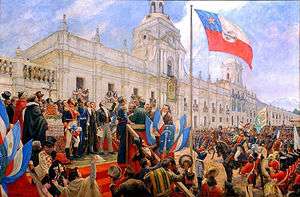Independence
%2C_by_John_Trumbull.jpg)

Independence is a condition of a nation, country, or state in which its residents and population, or some portion thereof, exercise self-government, and usually sovereignty, over the territory. The opposite of independence is the status of a dependent territory.
Definition of independence
Whether the attainment of independence is different from revolution has long been contested, and has often been debated over the question of violence as legitimate means to achieving sovereignty.[1] While some revolutions seek and achieve national independence, others aim only to redistribute power with or without an element of emancipation, such as in democratization within a state, which as such may remain unaltered. The Haitian Revolution, for example, began as a colony-wide slave uprising that was originally content with the pro-abolitionist French Republic, only to turn into a war of independence when Napoleon tried to re-install slavery. In contrast, the American Revolutionary War was intended to achieve independence from the beginning. Causes for a country or province wishing to seek independence are many, but most can be summed up as a feeling of inequality compared to the dominant power. The means can extend from peaceful demonstrations, like in the case of India, to a violent war like in the case of Algeria.
Distinction between independence and autonomy
Autonomy refers to a kind of independence which has been granted by an overseeing authority that itself still retains ultimate authority over that territory (see Devolution). A protectorate refers to an autonomous region that depends upon a larger government for its protection as an autonomous region.
Declarations of independence
Sometimes, a state wishing to achieve independence from a dominating power will issue a declaration of independence; the earliest surviving example is Scotland's Declaration of Arbroath in 1320, with the most recent example being Azawad's declaration of independence in 2012. Declaring independence and attaining it however, are quite different. A well-known successful example is the U.S. Declaration of Independence issued in 1776. The dates of established independence (or, less commonly, the commencement of revolution), are typically celebrated as a national holiday known as an independence day.
Historical overview
Historically, there have been three major periods of declaring independence:
- from the 1770s, beginning with the American Revolutionary War through the 1830s, when the last royalist bastions fell at the close of the Spanish American wars of independence;
- the immediate aftermath of the First World War following the breakup of the Ottoman and Austro-Hungarian empires;
- and 1945 to circa 1979, when seventy newly independent states emerged from the European colonial empires.[2]
Continents
| Continent | No. | Last Country to Gain Independence | |
|---|---|---|---|
 |
54 | ||
| 35 | |||
| 44[b] | |||
| 50[b] | |||
| 14 | |||
| 8 | de facto condominium international | ||
Notes
- ^ Independence from the United Kingdom.
- ^ a b Part of Transcaucasian Region, at the crossroads of Europe and Asia. Physiographically, Armenia falls entirely in Western Asia, while Georgia and Azerbaijan are mostly in Asia with small portions north of the Caucasus Mountains divide in Europe.
- ^ Partially recognized de facto self-governing entity. It is recognised by 110 UN members the Cook Islands, Niue and Taiwan. Claimed by Serbia as the Autonomous Province of Kosovo and Metohija under UN administration.
- ^ An independent state in free association with the United States.
See also
- Independence constitution
- Independence referendum
- List of national independence days
- List of sovereign states by date of formation
- Lists of active separatist movements
- Secession
- Special Committee on Decolonization
- War of Independence
- Unilateral declaration of independence
- United Nations list of Non-Self-Governing Territories
References
| Wikiquote has quotations related to: Independence |
- ↑ Benjamin, Walter (1996) [1921]. Walter Benjamin: Selected Writings, Volume 1: 1913–1926. Cambridge: Harvard University Press. 236–252. ISBN 0-674-94585-9.
- ↑ David Armitage, The Declaration of Independence in World Context, Organization of American Historians, Magazine of History, Volume 18, Issue 3, Pp. 61–66 (2004)
- ↑ "Kosovo" (PDF). Archived from the original (PDF) on 2008-02-16. Retrieved 30 July 2015.